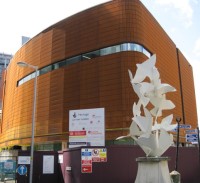MANCHESTER: Steeped in labour history
| |
 |
|
|
People's History
|
Not since Glasgow has National Delegate Conference landed on
somewhere so steeped in labour movement history.
From a Roman settlement in a Celtic heartland, to a medieval
market town, Manchester grew into a metropolis in the 19th century
with the massive growth in textile manufacturing. It is home to
the world’s first ever passenger railway station.
It even, somewhat oddly, raised a regiment to support Bonnie
Prince Charlie on his way south but turned on him on his way back.
In the 18th and 19th centuries the city was enriched by immigrants
from Ireland and central and eastern Europe as the place expanded
with canals, factories and the railway.
And radicalism grew. There were food riots in 1797. The Blanketeers
mounted a huge march in 1817 against poverty during the textile
recession and against the suspension of the Habeas Corpus Act.
60,000 gathered in St Peter’s Field in 1819 to demand parliamentary
representation. Cavalry charged protesters with sabres, killing
at least 15 and injuring hundreds in the ‘Peterloo Massacre’.
Manchester became a borough in 1837 and the council eventually
bought out the last of the feudal rights.
From 1842 to 1844 Friedrich Engels lived here and wrote his
Condition of the Working Class in England. He met with
Karl Marx in an alcove at Chetham’s Library (built 1653).
The Cooperative Wholesale Society was formed here in 1862. By
1895 over 300 local branches of the Labour Party had sprung up.
40,000 people gathered to hear Keir Hardie speak in 1896.
Emmeline Pankhurst founded the Women’s Social and Political Union
in Manchester in 1903 - better known as the suffragettes.
By 1906 there were three Manchester Labour MPs and the city council
had 13 Labour members. Today, 75 of the 96 councillors are Labour
with no Tories.
What a history, and we haven’t even touched on football yet.
Like Edinburgh, Manchester has a Hearts supporters club. Unlike
Edinburgh it has trams!
Modern Manchester had gone through a huge revival before the
savage ConDem cuts this year and there is much to see and do.
What to see
First stop has to be the magnificent People’s
History Museum telling the story from the chartists, trade
unions and the co-op movement to the Spanish Civil War and much
more - including a huge collection of banners and badges.
The
John Rylands Library collection includes the oldest known
piece of the New Testament, the St John Fragment, and a 1476 William
Caxton edition of Chaucer’s Canterbury Tales.
The
Manchester Museum, Museum
of Science and Industry and the
series of art galleries are all worth a visit.
Eating out
Manchester boasts a fantastic Chinatown
not far from the Town Hall and a famous Curry
Mile in Rusholme. The city centre has many restaurants near
the Conference centre, down by the canals, across to Piccadilly
and the area around the Cathedral and the Arndale Centre.
Pubs and Bistros
The supposedly smallest pub in Britain is the Circus
Tavern on Portland Street and there are a few good real ale
pubs around the area. Some trendy bars are to be found in Deansgate
with popular venues alongside the canals at Castlefield.
The gay scene centres on Canal
Street.
The ancient Wellington bar and Sinclairs Oyster bar are near
the big wheel. Astonishingly, the pubs have been physically moved
twice. Once in 1974 to make way for the shopping centre, then
again closer to the cathedral after the bombing of 1996.
John Stevenson
top |



